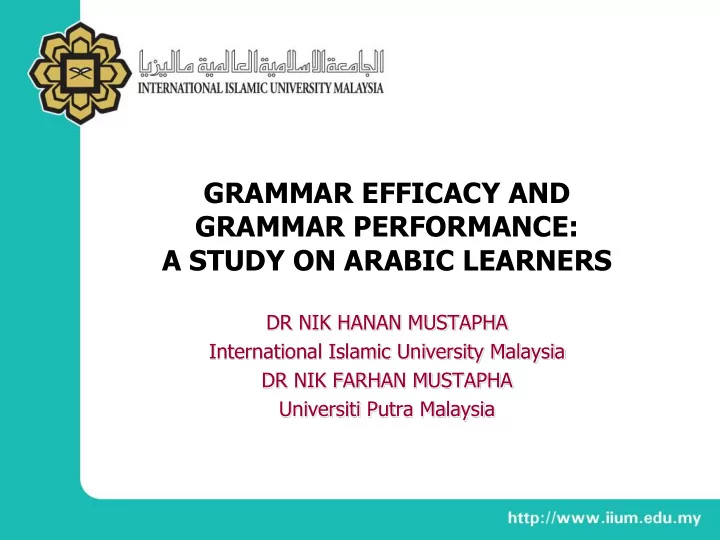

GRAMMAR EFFICACY AND GRAMMAR PERFORMANCE: A STUDY ON ARABIC LEARNERS DR NIK HANAN MUSTAPHA International Islamic University Malaysia DR NIK FARHAN MUSTAPHA Universiti Putra Malaysia
INTRODUCTION • The concept of self-efficacy • Self-efficacy in language learning
LITERATURE REVIEW • Self-efficacy in language learning positively affects students performance (Linnenbrink & Pintrich, 2003; Mills, Pajares & Herron, 2006; Mills, et.al, 2007; Pajares, 2003; Pajares & Johnson, 1994; Schunk, 2003; Schunk & Zimmerman, 2007) • Grammar efficacy as part of writing efficacy (Collins & Bissell, 2002; Pajares & Johnson, 1994; Shell, Colvin, & Bruning, 1995) • Research on grammar efficacy by Collins and Bissell (2004). • Self-efficacy in Arabic language learning in Malaysian context: Ghazali, Nik Mohd. Rahimi, Parilah, Wan Haslina and Ahmed Thalal • (2011) Mohamad Azrien and Shukeri (2011) • Nik Hanan, Nik Farhan, Nadwah and Mahmud (2013) •
THIS STUDY Objectives: • To investigate the level of grammar efficacy among Arabic learners • To examine the relationship between grammar efficacy and grammar • performance. Grammar efficacy in this research refers to learners’ perceived judgment in the • application of their grammar knowledge on three aspects: correction of grammar errors, vocalization of words, and construction of sentences. Self-efficacy should be task-based for accurate measurement (Pajares, 1996). • Research hypothesis: • H1 Students of Arabic are highly efficacious in their application of • grammar knowledge. H2 Grammar efficacy on error correction, words vocalization and • sentence construction positively correlate with grammar performance.
METHODOLOGY Participants: • ( n ) 140 students majoring in Arabic language in IIUM • Completed Syntax 3 and Morphology 2 • Male ( n =40) 29%, female ( n =100) 71% • Instruments: • A newly-developed questionnaire with 18 items • A set of question for performance measurement • Procedure: • During regular class time • Questionnaire was administered before the test •
Exploratory factor analysis 18 items correlate fairly well (0.313 to 0.746). • KMO Measure of Sampling Adequacy was .89. • Bartlett’s test of sphericity was significant (χ 2 (140) =1421, p < .05). • Item communalities range between .53 to .79. • The three-factor solution obtained from the principal component analysis with • varimax rotation explained 63.48% of the total variance: First factor, the first 7 items represent correction of grammatical errors. • Explains 43.44% of the variance. Cronbach Alpha 0.87. Second factor, the next six items represent vocalization of words. Explains • 11.89% of the variance. Cronbach Alpha 0.87. Third factor, the last five items represent sentence construction. Explains • 8.16% of the variance. Cronbach Alpha 0.84 All Cronbach alpha values exceed the minimum threshold of 0.70 (Nunally, • 1978).
RESULTS Students level of grammar efficacy • Mean Std. Deviation Overall grammar efficacy 4.61 0.79 Efficacy of words vocalization 4.96 0.86 Efficacy of sentence construction 4.76 0.93 Efficacy of error correction 4.21 1.02
RESULTS Grammar efficacy and grammar performance • Error Word Sentence Overall correction efficacy vocalization construction efficacy efficacy efficacy Pearson Correlation .255 ** .377 ** .400 ** .397 ** Achievement on error Sig. (2-tailed) .002 .000 .000 .000 correction N 140 140 140 140 Pearson Correlation .226 ** .348 ** .346 ** .354 ** Achievement on word Sig. (2-tailed) .007 .000 .000 .000 vocalization N 140 140 140 140 Achievement on Pearson Correlation .225 ** .418 ** .380 ** .390 ** sentence Sig. (2-tailed) .007 .000 .000 .000 construction N 140 140 140 140 Pearson Correlation .284 ** .459 ** .454 ** .459 ** Overall achievement Sig. (2-tailed) .001 .000 .000 .000 N 140 140 140 140 **. Correlation is significant at the 0.01 level (2-tailed).
DISCUSSION Learners of Arabic are efficacious grammar learners, in line with Collins and Bissell, • 2004; Nik Hanan et al., 2013) Most confidence in words vocalization, particularly applied in reading. • Reading skill is the most important for Arabic learners in Malaysian context (Asmah, • 1982). Contemporary texts are largely unvocalized. • Learners are more efficacious in sentence construction as compared to error • correction. Moderate positive association between grammar efficacy and grammar performance • differs slightly from the study by Collins and Bissell (2004). Association between sentence construction efficacy and its performance revealed • the highest correlation.
CONCLUSION Relevance of self-efficacy in learning Arabic grammar. • Development of an appropriate assessment for measuring Arabic grammar • efficacy.
THANK YOU
Recommend
More recommend